REAL TESTS! 2010 MXA 250 FOUR-STROKE SHOOTOUT: CRF250 vs.YZ250F vs TC250 vs KX250F vs 250SXF
The 2010 MXA 250 Four-Stroke Shootout is the most comprehensive test that you will find in any magazine, on any website, or anywhere else. MXA leaves no stone unturned, and while we will probably no longer receive Christmas cards from several manufacturers after this shootout, we tell the whole truth so that you can make the best purchasing decision. Simply said, if you’re in the market for a 2010 250 four-stroke, this test is for you. It’s worth mentioning that the 2010 Suzuki RM-Z250 isn’t included in this shootout, as Suzuki did not make the bike available during the prescribed test period.
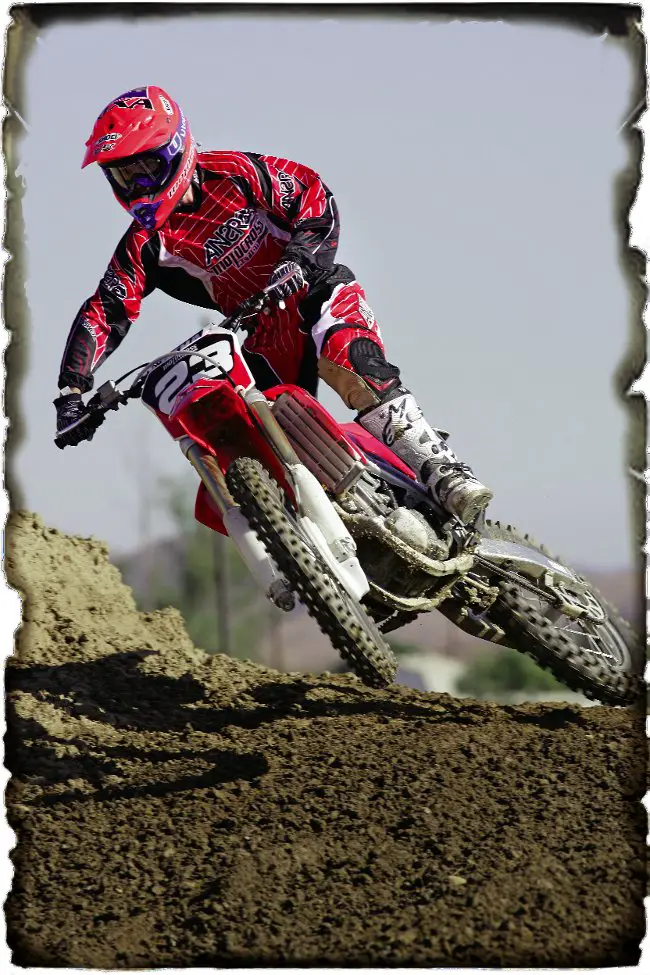
WHICH 2010 250 FOUR-STROKE RECEIVED THE MOST CHANGES FOR 2010?
(1) Honda. The CRF250 clearly had the most changes for 2010. Not only did they trump the competition in minor changes, but also in monumental updates. The CRF250 frame is all-new from the ground up (although it’s a spitting image of the 2009 CRF450 frame), as is the programmable fuel injection, engine, gas tank, body styling and exhaust.
(2) Yamaha. Typically, Yamaha sticks with the same basic YZ250F package; however, for 2010 Yamaha threw caution to the wind and released a new bilateral beam frame. Other changes included engine updates, a lengthened exhaust system, repositioned shock, smaller gas tank, lowered radiators and radically different body styling.
(3) Husqvarna. Husqvarna’s savvy marketing department pegged the 2010 TC250 as being all-new, but in reality this bike was released in Europe last year. All-new is a loose term for the Husqvarna TC250, because quite a few parts were carry-over items from previous models. However, there’s no disputing that the minuscule engine is radically different from anything that we’ve seen before on a 250 four-stroke. The TC250 also comes with Kayaba forks and a frame change (the TC250 used to share its frame with the TC450, but for 2010 it uses the Husqvarna CR125 two-stroke frame).
(4) Kawasaki. With roughly 33 updates made over the calendar year, it’s hard to believe that the 2010 Kawasaki KX250F only ranks fourth on the list of most changes. Kawasaki refined the KX250F, but these advancements are minor in comparison to the major frame, engine and suspension changes that other manufacturers made. Instead of throwing the baby out with the bathwater, Kawasaki fine-tuned problem areas. Updates were made to the engine (more horsepower), handling (revised steering stem shaft angle), transmission (smoother shifting), swingarm (improved rigidity characteristics), radiators (better torsional rigidity), suspension (stability under acceleration) and exhaust (tapered for more bottom-end power).
(5) KTM. Like Kawasaki, KTM stuck with their basic package from last year. Where the two differ is in the number of changes for 2010. KTM was tentative in comparison to every other manufacturer, but that’s not necessarily a bad thing. The 250SXF received updates to the engine, triple clamps, airbox, suspension, brakes, exhaust and cosmetics.
WHICH 2010 250 FOUR-STROKE HAS THE BEST ALL-AROUND POWERBAND?
(1) Kawasaki. The KX250F powerplant is the pride of the 250 four-stroke class. None of the other 250Fs could match the KX250F across the entire powerband. It does its best work from just below the midrange on through the top-end. The YZ250F is better down low, and the KTM 250SXF is superior on top, but every single test rider selected the KX250F engine for racing. Casual riders will also enjoy the powerband, as it’s fun and works well in many riding situations.
(2) KTM. The KTM 250SXF is a for-racers-only engine. The power comes on slowly, builds steadily through the midrange and screams into the top-end. The 250SXF engine doesn’t sign off until the fat lady has already sung and caught a cab ride home. In stock form, the engine favors advanced-level riders, but with gearing and exhaust changes, the 250SXF can be competitive in the hands of Novice and Vet riders.
(3) Honda. The MXA wrecking crew misses last year’s 2009 CRF250 powerplant. And getting misty about last year’s engine while discussing the 2010 engine isn’t a good sign. What went wrong? Honda opted for a midrange-only engine instead of the do-it-all powerplant of last year. The 2010 CRF250 is fast in the right hands, but it demands constant shifting and judicious use of the clutch. The only reason that the CRF250 finished third in the engine category is because Yamaha and Husqvarna stunk up the joint.
(4) Yamaha. Someone needs to inform Yamaha’s engineers that 250 four-stroke riders aren’t looking for bottom-end-only power. The MXA wrecking crew has beaten a dead horse by harping on the YZ250F’s lack of midrange and top-end power for as long as we can remember. Something needs to change. The YZ250F is the king of bottom-end power, but that’s not saying much. To successfully ride the 2010 YZ250F to its maximum potential requires quick shifting through the five-speed transmission.
(5) Husqvarna. Slow as molasses in January best describes the TC250 powerplant. The engine lacks hit, snap and punch. Instead, it is anemic, lackadaisical and sickly. While test riders marveled at the compact engine design, there must be a correlation between the small engine and the minute powerband.
WHICH 2010 BIKE IS BEST ON THE DYNO?
(1) KTM. KTM’s engineers know how to pump out ponies. Once again, the 250SXF earns top honors for most peak horsepower in the 250 four-stroke class. Last year, the KTM romped the competition with over 1-1/2 horses more than any other bike. For 2010, KTM utilized a longer muffler with a smaller and straighter core to reduce sound, which hampered maximum horsepower. Still, the 250SXF is the king of the dyno. The power is almost nonexistent from 5000 rpm through 10,000 rpm, but then it builds quickly and is best in the class from 11,800 rpm through 13,200 rpm. The 250SXF produces 36.90 horsepower at 12,200 rpm with 19.33 foot-pounds of torque.
(2) Kawasaki. What a difference a year makes! In 2009, the KX250F produced the least horsepower in the class, but the 2010 powerplant jumps up to second place in maximum horsepower. The new model carries a one-horsepower increase throughout the entire powerband compared to last year. On the dyno, the KX250F leads the class from 6000 rpm through 9600 rpm. At that point, it remains close to the CRF250 and doesn’t waver until around 12,200 rpm. The KX250F produces 36.48 at 12,000 rpm with 19.53 foot-pounds of torque.
(3) Honda. The dyno chart shows the CRF250 producing the most horsepower from 9,700 rpm to 11,800 rpm, which makes sense considering the 2010 CRF250 has a midrange-only engine. Off the bottom, the Honda produces the least horsepower (from 5900 rpm to 7400 rpm). It is best in the class through the midrange and then starts fluttering like an EKG monitor at 11,000 rpm until it noses over at 13,300 rpm. The CRF250 produces 36.37 horsepower at 10,400 rpm with 19.18 foot-pounds of torque.
(4) Yamaha. For the second year running, the YZ250F finishes fourth in the class in the peak horsepower category. The YZ250F is at its best from 6000 rpm to 8500 rpm (from the bottom-end and leading into the midrange). After that, the 2010 YZ250F goes relatively flat until it suddenly gains a hint of top-end power from 11,000 rpm to 12,000 rpm. Short shifting is a must for maximizing the low-end powerband. The YZ250F produces 35.88 horsepower at 11,500 rpm with 19.19 foot-pounds of torque.
(5) Husqvarna. The 2010 TC250 does have the most horsepower on at least one section on the dyno curve, but it’s in an area that doesn’t count. The TC250 is the best in class from 5000 rpm to 5800 rpm (when the bike is just off idle). From 5800 rpm upward, the Husqvarna produces the least amount of horsepower, particularly from 10,500 rpm through 13,200 rpm. At 12,000 rpm the engine is down 3.5 horsepower to every other bike. The TC250 produces 34.26 horsepower at 10,800 rpm with 18.89 foot-pounds of torque.
WHICH 2010 250 FOUR-STROKE HANDLES THE BEST?
(1) Yamaha. The Yamaha YZ250F received a new frame, and while it improved the handling traits of the bike, it’s not perfect. The front end doesn’t understeer, and the chassis seems to handle various track situations (braking bumps, ruts, berms and jumps) with relative ease, but we had to install stiffer fork springs in order to achieve success. The 2010 YZ250F is the best handling bike in this group, but it’s not the best handling bike that we’ve ever ridden.
(2) Husqvarna. Another member of the undersprung fork club, the TC250 carves a solid line wherever it’s pointed (once the forks are fixed). Test riders liked the chromoly steel frame because of the bike’s ability to flex through ruts and down rough straightaways. The TC250 also handles quite well because it is slow.
(3) Kawasaki. Kawasaki understands that they have a handling problem. How do we know? They decreased the steering stem shaft angle to tighten up the cornering on the KX250F, and they changed the linkage ratio with a longer pullrod and rocker arm. The revisions helped, but they didn’t make a night-and-day difference. The front end still has a tendency to push from center-out, especially in fast sweeping corners. Under heavy acceleration, the rear wallows?just not quite as much as on previous models.
(4) KTM. The 250SXF’s forks are the weak link in an otherwise solid handling machine. Midstroke harshness has become commonplace with the 250SXF forks. On previous models, the harshness loosened fillings in our teeth. In an effort to solve the fork issue, KTM lowered the oil height and revised their damping settings. These changes didn’t work. We removed 15cc of oil out of each fork leg, but it was still difficult to find settings that worked well. It’s disheartening that the forks are harsh, because KTM improved their shock for 2010. We hope that KTM figures out their fork issues for 2011, because without good forks you can’t get the chassis to do what you want it to.
(5) Honda. Depending on the track, the 2010 Honda CRF250 either handles like a dream or your worst nightmare. The new frame geometry is too radical for most tracks. It causes the front end to knife in corners and headshake like fans at a Limp Bizkit concert. Honda moved the front wheel 15mm closer to the engine and steepened the head angle, but the forks are too soft to keep the front end up. We installed stiffer fork springs and set the fork leg height flush with the top triple clamp. Even then, many test riders weren’t comfortable on the CRF250.
WHICH 2010 BIKE HAS THE BEST SUSPENSION?
(1) Kawasaki. Often the bike with the fewest number of issues wins a specific category in a shootout. Such is the case with the 2010 KX250F suspension..it wins the suspension category, but without a rave review. The Showa units aren’t amazing, but they are reliable and have ballpark base settings. Beware of the sensitivity of the shock’s high-speed compression knob. We use the high-speed compression to adjust the ride height at speed.
(2) Yamaha. In stock trim, the YZ250F’s Kayaba SSS suspension isn’t well-balanced. The shock feels high in its stroke, and the forks hit a shelf of excessive compression damping about two-thirds of the way through their stroke. Faster and heavier riders will need to install stiffer fork springs (and lower the oil height by 20mm), while lighter and slower riders should drop the oil height by 10cc (but keep the stock springs). Once in balance, the Kayaba units work quite well (in comparison to every other suspended bike finishing below the YZ250F).
(3) Husqvarna. A member of the undersprung fork club, the TC250’s Kayaba units are too soft for all but slower or lighter riders. Stiffer fork springs are a must-do change. However, the Swedish-built Sachs shock is good at soaking up braking bumps and chatter.
(4) KTM. Even thinking about the midstroke harshness of the KTM 250SXF WP forks makes our wrists ache. In very small chatter, the forks are plush, but once the bike slams into braking bumps, the forks reach a shelf of unwanted harshness. We lowered the oil height in search of resolution. Unlike with past models, the 2010 KTM 250SXF has a shock setting that is consistently smooth and responsive without making the rear end step out unpredictably or pack up.
(5) Honda. The 2010 Honda CRF250 finished last place in the suspension shootout because it is the bike with the biggest need for stiffer fork springs. The bike is unbalanced and stinkbugs in stock trim. Swapping out fork springs is a must. Then and only then will the CRF250 refrain from its nasty headshake tendencies.

WHICH 2010 BIKE HAS THE BEST JETTING?
(1) Honda. For four years running, the CRF250 has been plagued with the worst jetting in the class. The 40mm Keihin carb was too large for the CRF250, and the bike bogged with regularity under heavy acceleration. Honda finally addressed the error with new technology in the form of electronic fuel injection. The 50mm throttle body with a 12-hole injector is excellent. Crisp and clean throttle response replaces the atrocious bog that was prevalent on last year’s CRF250. It’s also nice that the great throttle response isn’t affected by temperature or altitude.
(2) Yamaha. The YZ250F is the best carbureted bike in this shootout. It has near-perfect jetting. A full turn in on the fuel screw was the only adjustment that we made to clean up the slight hesitation directly off idle.
(3) Kawasaki. Changes were made to the fuel screw in order to rid the bike of a hesitation off idle. In warmer climates, the KX250F is too rich in the meat of the powerband. We used a leaner mainjet and went in slightly on the fuel screw.
(4) KTM. Off idle, the 250SXF had a slight bog. To remedy the problem, we leaned out the Keihin FCR carb by dropping the pilot, lowering the clip position, going out on the fuel screw, and turning the accelerator pump screw. Getting to the accelerator pump screw is no easy task, but it’s a must-do adjustment.
(5) Husqvarna. The lackluster jetting specs on the Husqvarna TC250 are partially to blame for the bike’s inability to start when hot. The TC250 carburetor acts like a drunk at happy hour. It burps, sputters and fails to function properly. We went leaner on the main, lowered the clip position on the needle and turned the fuel screw out, but we still couldn’t figure out how to kick-start the bike to life.
WHICH 2010 BIKE HAS THE BEST GEARING?
(1) Honda. There weren’t any complaints voiced by test riders concerning the CRF250 gearing. We tried different gearing combinations, but nothing worked as well as the stock setup. The CRF250 is one of only two bikes in the shootout that didn’t need a gearing change.
(2) Husqvarna. Various gearing changes only hurt the TC250 engine. Adding a tooth forced the engine to wind out too quickly, while the powerplant couldn’t pull taller gearing. Opt for taller gearing only if you affix a rocket launcher to the rear fender.
(3) Yamaha. Yamaha is usually on the mark when it comes to gearing, but due to the punchy bottom end power on the 2010 YZ250F, we geared the bike taller to spread out the powerband. A 48-tooth rear sprocket will help, but it takes an aftermarket exhaust system to boost midrange power.
(4) Kawasaki. For anyone but Intermediate or Expert level riders, the stock gearing on the 2010 KX250F is too tall. We added a tooth to the rear sprocket, which immediately helped the bike blast out of ruts and maximized the breadth of the powerband.
(5) KTM. KTM didn’t get the memo this year (or last year, or the year before that) about their tall gearing. In stock trim, the six-speed transmission has wide gaps between each gear. Unless you have corner speed like James Stewart or like melting clutch plates with regularity, you’ll need to swap the 48-tooth rear sprocket for a 49.

WHICH 2010 BIKE HAS THE BEST CLUTCH?
(1) KTM. The Brembo hydraulic clutch has long been a favorite among MXA test riders. The smooth and fluid feel is an acquired taste for riders who like stiff clutch pull, but we love the hydraulic unit. We would be happy to see hydraulic clutches on the Japanese bikes. Until then, KTM is ruler of the clutch confederacy.
(2) Yamaha. There is nothing special about the YZ250F clutch, but it is a reliable and consistent workhorse. Without serious abuse, the YZ250F clutch lasts a long time.
(3) Honda. The CRF250 clutch lacks any frills, but that’s not a bad thing. Without serious abuse, the clutch lasts a substantial amount of time before new plates and fibers are needed. But, be forewarned, the 2010 clutch springs are very weak. When the clutch starts to slip, it will go out fast.
(4) Kawasaki. We baked the KX250F clutch in six hours, and the clutch pull was very light. To improve performance and lengthen clutch life, we used Pro Circuit clutch springs.
(5) Husqvarna. It’s odd that we would rate the Brembo hydraulic clutch on the KTM 250SXF in first place, while the Brembo unit on the Husqvarna TC250 is the worst in the class. These units are different, and for some unknown reason the TC250 clutch faded when it got hot and became unresponsive following heavy acceleration. We even bled the system for possible air bubbles, but the clutch still acted up.

WHICH 2010 BIKE HAS THE BEST BRAKES?
(1) Husqvarna. There are two reasons why the TC250 has the best brakes in the class. First, the Brembo brakes are powerful and progressive. Second, the TC250 is very slow, so getting the bike to stop is an easy task.
(2) KTM. We raved about the stop-on-a-dime front brake from last year, but KTM changed their pad compound for a less grabby feel. Many test riders preferred the 2009 KTM 250SXF brakes to the 2010 units. For a stronger feel, use the brake pads from the 2010 KTM 450SXF.
(3) Yamaha. The YZ250F has relatively strong, no-nonsense brakes. The rear is stronger and more progressive, but the front still works quite well.
(4) Kawasaki. Fair is the word that best describes the 2010 KX250F brakes. The brakes are rather weak, and if the CRF250 didn’t come with the silly front disc guard, the KX250F would be in the cellar.
(5) Honda. The CRF250 has strong brakes, but the front disc guard reduces airflow to the disc, causing weak stopping power. Meanwhile, the small brake pads in the rear don’t get along with brake draggers. Once we removed the guards, (front and rear) the brake power was restored.
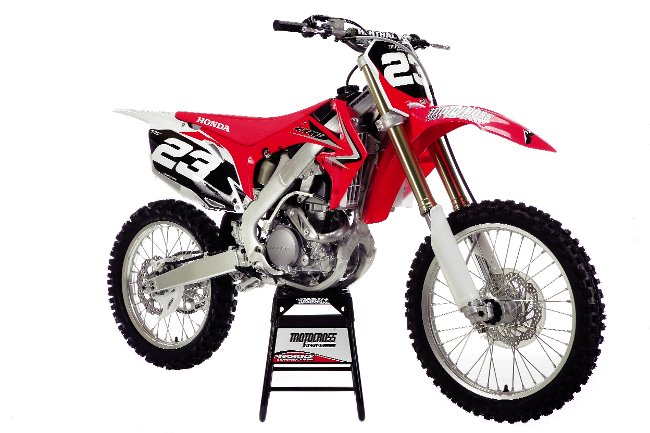
WHICH 2010 BIKE HAS THE BEST STOCK TIRES?(1) Yamaha. Last year, Yamaha worked with Bridgestone to spec their own special 403A front tire. The knobs are sharper, and the tire itself has a flatter tread pattern to provide for a wider footprint. The Bridgestone 403A/404 tire combo is the best sneaker package of the bunch.(2) Kawasaki. Most MXA test riders preferred the Yamaha-specific Bridgestone M403A front tire over the basic M403, but the original 403 is still very good. Matched with the M404 rear, the KX250F sticks well in many different kinds of dirt.
(3) Husqvarna. It makes sense that a European manufacturer would use tires from a European tire company. The Pirelli-equipped MT32 tires work well in soft-to-intermediate dirt.
(4) KTM. While it may not be true that cavemen used Bridgestone’s M59/M70 tire combination on their stone-wheeled carts in prehistoric times, the M59/M70 combo is old. Amazingly, it is still quite good. The tires work well in soft-to-intermediate terrain and don’t do anything strange on hardpack or in mud.
(5) Honda. The MXA wrecking crew enjoyed nearly every tire that came on the 2010 250 four-strokes, until we came across the CRF250. The Dunlop D742FA front tire resulted in more front-end washouts than any other tire in recent memory (save for the original D742). It has a split personality. Though it tracks well through intermediate terrain, the tire slides like a greased pig on linoleum once it hits hardpack.
HOW WOULD THE MXA TEST CREW DESCRIBE EACH BIKE (ALPHABETICALLY)?
Honda CRF250. Honda went all-new for 2010. After refining their CRF250 to near perfection last year, they threw caution to the wind with electronic fuel injection, a new frame and different engine. We wish that we could turn back the hands of time and warn Honda of their ensuing blunders. The 2009 CRF250 was a winner, while the 2010 CRF250 is a poor-handling bike with a midrange-only engine.
Husqvarna TC250. If you want to be different, the 2010 Husqvarna TC250 is for you. It has the smallest and lightest engine in the class, as well as a unique look and chromoly steel frame. It also has many quirks that require patience and money to fix. The Kayaba forks are soft, the engine is slow, the jetting is confused and it won’t start.
Kawasaki KX250F. Although not all-new or groundbreaking, the 2010 KX250F received a shopping list of changes. The engine is made for racing and caters to faster Novice through Pro-level riders. The suspension is decent, but the bike could handle better in certain situations. Stock gearing makes it difficult for Beginner and Vet riders to keep the engine on the pipe, and there are other minor problems that we encountered. Overall, however, it’s still an excellent 250 four-stroke.
KTM 250SXF. If horsepower is your main concern, then the 2010 KTM 250SXF is for you. It pumps out 37 horsepower (and if you put last year’s stock muffler on, it would top 39 horsepower). The 250SXF also handles well once the harsh forks are fixed, but the powerband is too much for all but Intermediate and Pro-level riders.
Yamaha YZ250F. We expected the 2010 YZ250F to be fuel injected (and if the perimeter frame and flat-bottom gas tank are any indication, so did Yamaha). Yamaha did develop a new frame, exhaust and body styling. However, the engine is pretty much the same old Bessie. It’s a bottom-end-only powerplant that suits Beginner and Novice riders. Faster riders will need to invest in an exhaust system and engine work if they want to get anywhere around the track.
THE 2010 MXA 250F SHOOTOUT WINNER IS…
(1) Kawasaki KX250F. A host of updates that benefit the overall KX250F package? Check. A more powerful engine that works well across the entire powerband? Check. Acceptable handling, decent suspension and good tires? Check, check and check. Kawasaki has catapulted their KX250F to the top of the 250 four-stroke class once again by refining an already solid engine. This is the bike to have for 2010.
(2) KTM 250SXF. It wasn’t easy, but KTM managed to finish runner-up in our 250 four-stroke shootout. How did the Austrians manage such a feat? Horsepower! And horsepower alone. The 250SXF engine is a screamer. Every tester raved about the engine’s ability to pull well beyond the realm of every other bike in its class. Also on the list of likes are the handling, clutch and brakes. There is still much room for improvement (gearing, suspension, and jetting), but for 2010 the 250SXF is the best of the rest.
(3) Yamaha YZ250F. Sensing that a major update was necessary, Yamaha poured R&D dollars into the 2010 YZ250F. A new frame, countless engine modifications, a beefy clutch and lowered radiators were some of the key changes. The 2010 YZ250F is improved over the 2009 model, but many testers weren’t elated. Yamaha needs to develop a new engine that focuses more on midrange and top-end power. It also wouldn’t hurt the blue boys to get back to their previously excellent Kayaba SSS fork specs.
(4) Honda CRF250. Research and development don’t mean diddly if the updates hamper performance. Honda took one step forward and three steps back with the 2010 CRF250. While the dreaded bog is gone, the frame, engine, gearing and forks are amiss. New technology isn’t always the best thing, especially when the bike was so good last year. The 2010 Honda CRF250 handles poorly and has a midrange-only powerband, overly soft forks and a suspect front tire.
(5) Husqvarna TC250. We applaud Husqvarna for trying to rejoin the 250 four-stroke fray. The Italians came out with a diminutive engine (smallest in the class), Kayaba forks (from the 2007 YZ250F), and even managed to fit the TC250 powerplant in their CR125 two-stroke frame. Every company has to start somewhere, and Husky has laid the groundwork for a future winner.
MXA’S RECOMMENDED 2010 SETTINGS
MXA’S RECOMMENDED 2010 JETTING SETTINGS
HONDA CRF250
Throttle body: Keihin 50mm
Injector: 12-hole
Injector size: 60 micron
Fuel pump/pressure: Electric/50 psi
Fuel map: Adjustable (with optional tool)
Idle: 60 clicks out
Notes: The idle clicker is the choke knob. It can be pulled out and clicked out (counter-clockwise) to increase idle speed. It was really designed as an air/fuel control, not an idle screw.
HUSQVARNA TC250
Mainjet: 180 (190 stock)
Pilot: 40
Needle: OBDVR
Clip position: 3rd from top (5th from top)
Fuel screw: 2 turns out (1-1/2 turns out)
Notes: This is the old-style Keihin FCR carb with the hot start on the carb body.
KAWASAKI KX250F
Mainjet: 185
Pilot: 40
Needle: NHJT
Leak jet: 55
Clip position: 4th from top
Fuel screw: 1-3/4 turns out (2 turns out)
Slide: 1.5
Notes: The NHJT needle was new last year. The taper has a gradual progression (unlike the 2008 needle, which was stepped).
KTM 250SXF
Mainjet: 175
Pilot: 38 (40)
Needle: OBEKP
Leak jet: 50
Clip position: 3rd from top (4th from top)
Fuel screw: 1-1/2 turns out (1-1/4 turns out)
Notes: On the accelerator pump, we turned the screw in until it made contact with the pump and then backed it out 1/4 of a turn. From the contact point, back the adjustment screw out (counting turns as you go). This is a must-do adjustment.
YAMAHA YZ250F
Mainjet: 180
Pilot: 45
Needle: NDJR
Clip position: 4th from top
Fuel screw: 3/4 turn out (1-3/4 turns out)
Leak jet: 70
Notes: The needle is richer by a half-clip compared to the 2009 needle. For high altitude, we recommend switching to a 178 mainjet with the clip in the 3rd position. For cold weather, we recommend swapping the 180 mainjet for a 182 and adjusting the fuel screw to 2-1/4 turns out.
MXA’S RECOMMENDED 2010 FORK SETTINGS
HONDA CRF250
Spring rate: 0.46 kg/mm (0.45 kg/mm)
Oil quantity: 342cc
Compression: 8 clicks out (13 clicks out)
Rebound: 8 clicks out
HPSD: 4 clicks out (7 clicks out)
Fork leg height: Flush with top clamp
Notes: The 48mm Showa forks come with a separate aluminum screw on top of the fork legs. Don’t use it to bleed air out of the forks! It is only to be unscrewed when the forks are being serviced. Use the brass screw to bleed air out of the fork legs. We believe that any rider over 150 pounds would benefit from stiffer fork springs.
HUSQVARNA TC250
Spring rate: 0.45 kg/mm (0.43 kg/mm)
Oil height: 290cc
Compression: 14 clicks out (9 clicks out)
Rebound: 16 clicks out (13 clicks out)
Fork leg height: 5mm up
Notes: The Kayaba forks on the TC250 come straight off the 2007 Yamaha YZ250F?which is a good thing, because it means that mods that worked on the YZ will work on the Husky (starting with stiffer fork springs).
KAWASAKI KX250F
Spring rate: 0.44 kg/mm
Oil height: 306cc
Compression: 8 clicks out (10 clicks out)
Rebound: 8 clicks out (9 clicks out)
Fork leg height: 5mm up (7mm up)
Notes: If you have to go less than six clicks out on compression, you should step up to the next stiffest spring rate.
KTM 250SXF
Spring rate: 0.46 kg/mm
Oil height: 350cc (365cc)
Compression: 10 clicks out (12 clicks out)
Rebound: 11 clicks out (12 clicks out)
Fork leg height: 5mm up
Notes: When the forks are new, they need about an hour of riding to break in. Smaller riders might opt to lower the oil height by 20cc (from stock).
YAMAHA YZ250F
Spring rate: 0.46 kg/mm (0.45 kg/mm)
Oil quantity: 330cc (350cc stock
Compression: 2 clicks out (8 clicks out)
Rebound: 8 clicks out (10 clicks out)
Fork leg height: 5mm up
Notes: Slower and smaller riders can get away with using the stock 0.45 kg/mm fork spring rate (with 340cc of fork oil), while heavier and faster riders should jump up a spring rate (and lower the oil height to tune the midstroke to their tastes). Doing so will keep the forks up in their stroke and help prevent the forks from diving.
MXA’S RECOMMENDED 2010 SHOCK SETTINGS
HONDA CRF250
Spring rate: 5.3 kg/mm
Race sag: 105mm
Hi-compression: 1-1/16 turns out
Lo-compression: 7 clicks out
Rebound: 10 clicks out (11 clicks out)
Notes: The shock is very sensitive to high-speed compression. Heavier riders should go in 1/4 turn on high-speed compression and set the sag at 100mm.
HUSQVARNA TC250
Spring rate: 5.4 kg/mm
Race sag: 100mm
Hi-compression: 11 clicks out (10 clicks out)
Lo-compression: 16 clicks out (15 clicks out)
Rebound: 16 clicks out (18 clicks out)
Notes: We recommend running between 100mm and 105mm of sag to maximize the Sachs shock’s potential.
KAWASAKI KX250F
Spring rate: 5.4 kg/mm
Race sag: 100mm
Hi-compression: 1-1/4 turns out (2-1/4 turns out)
Lo-compression: 8 clicks out (11 clicks out)
Rebound: 9 clicks out (11 clicks out)
Notes: We think the KX250F works best with the low-speed compression turned in, while using the high-speed to adjust the ride height at speed.
KTM 250SXF
Spring rate: 6.9 kg/mm
Race sag: 110mm
Hi-compression: 1-1/4 turns out (1-1/2 turn out)
Lo-compression: 12 clicks out (15 clicks out)
Rebound: 25 clicks out (24 clicks out)
Notes: KTM recommends running between 105mm and 110mm of race sag to maximize the shock’s potential. Also, if you need to go further than 26 clicks out on rebound, then it’s best to switch to a 6.6 kg/mm shock spring.
YAMAHA YZ250F
Spring rate: 5.3 kg/mm
Race sag: 105mm
Hi-compression: 2-1/4 turns out (1-3/4 turns out)
Lo-compression: 7 clicks out (9 clicks out)
Rebound: 9 clicks out (10 clicks out)
Notes: Riders who don’t need heavier fork springs should run upwards of 105mm of sag.


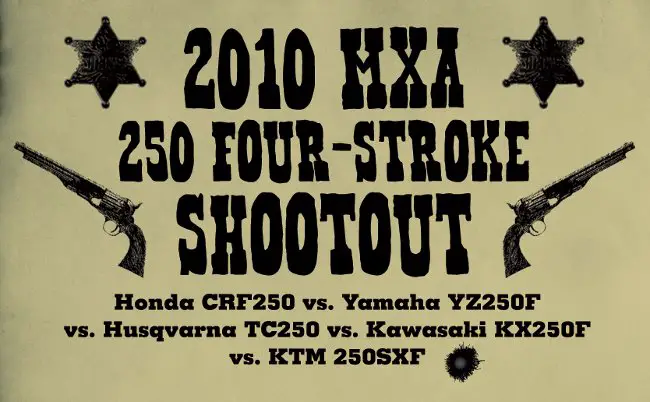

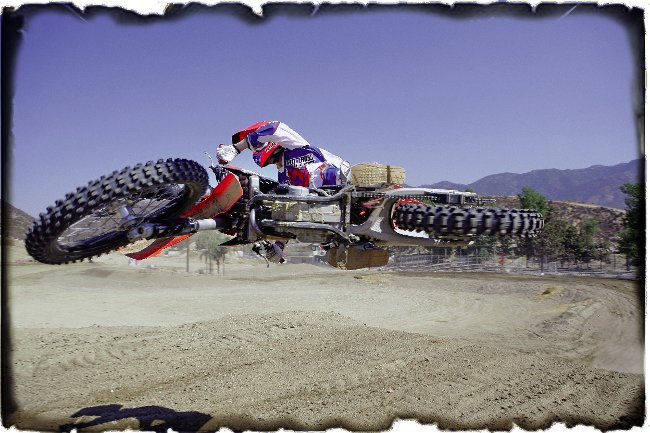
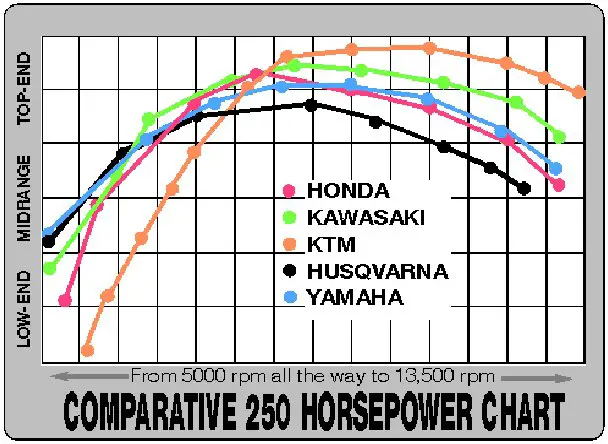
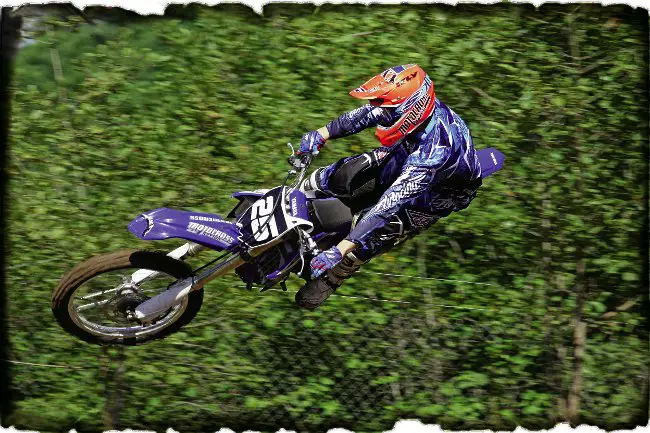
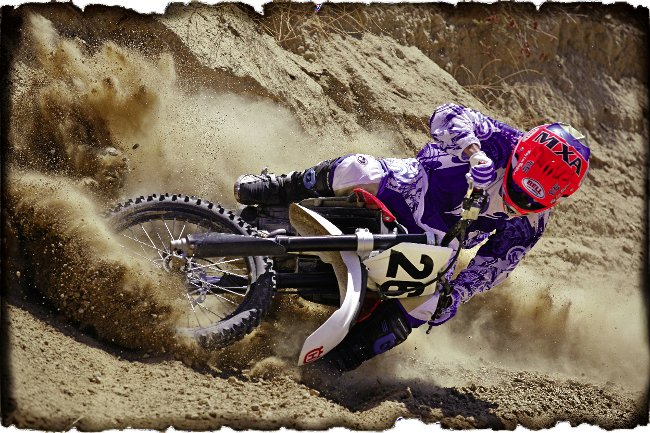





Comments are closed.